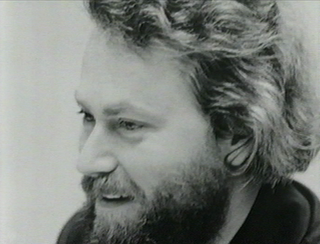
Donald Clarence Judd was an American artist associated with minimalism. In his work, Judd sought autonomy and clarity for the constructed object and the space created by it, ultimately achieving a rigorously democratic presentation without compositional hierarchy. He is generally considered the leading international exponent of "minimalism," and its most important theoretician through such writings as "Specific Objects" (1964). Judd voiced his unorthodox perception of minimalism in Arts Yearbook 8, where he says, "The new three dimensional work doesn't constitute a movement, school, or style. The common aspects are too general and too little common to define a movement. The differences are greater than the similarities."

Shaped canvases are paintings that depart from the normal flat, rectangular configuration. Canvases may be shaped by altering their outline, while retaining their flatness. An ancient, traditional example is the tondo, a painting on a round panel or canvas: Raphael, as well as some other Renaissance painters, sometimes chose this format for madonna paintings. Alternatively, canvases may be altered by losing their flatness and assuming a three-dimensional surface. Or, they can do both. That is, they can assume shapes other than rectangles, and also have surface features that are three-dimensional. Arguably, changing the surface configuration of the painting transforms it into a sculpture. But shaped canvases are generally considered paintings.

Constructivism is an early twentieth-century art movement founded in 1915 by Vladimir Tatlin and Alexander Rodchenko. Abstract and austere, constructivist art aimed to reflect modern industrial society and urban space. The movement rejected decorative stylization in favour of the industrial assemblage of materials. Constructivists were in favour of art for propaganda and social purposes, and were associated with Soviet socialism, the Bolsheviks and the Russian avant-garde.
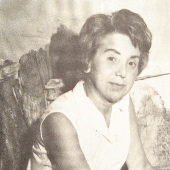
Jane Schenthal Frank was an American multidisciplinary artist, known as a painter, sculptor, mixed media artist, illustrator, and textile artist. Her landscape-like, mixed-media abstract paintings are included in public collections, including those of the Corcoran Gallery of Art, the Baltimore Museum of Art, and the Smithsonian American Art Museum. She studied with artists, Hans Hofmann and Norman Carlberg.

Raimund Johann Abraham was an Austrian architect.

Conrad Marca-Relli was an American artist who belonged to the early generation of New York School Abstract Expressionist artists whose artistic innovation by the 1950s had been recognized across the Atlantic, including Paris. New York School Abstract Expressionism, represented by Jackson Pollock, Willem de Kooning, Franz Kline, Robert Motherwell, Marca-Relli and others became a leading art movement of the postwar era.

Norman K. Carlberg was an American sculptor, photographer, and printmaker. He is noted as an exemplar of the modular constructivist style.
Modular constructivism is a style of sculpture that emerged in the 1950s and 1960s and was associated especially with Erwin Hauer and Norman Carlberg. It is based on carefully structured modules which allow for intricate and in some cases infinite patterns of repetition, sometimes used to create limitless, basically planar, screen-like formations, and sometimes employed to make more multidimensional structures. Designing these structures involves intensive study of the combinatorial possibilities of sometimes quite curvilinear and fluidly shaped modules, creating a seamless, quasi-organic unity that can be either rounded and self-enclosed, or open and potentially infinite. The latter designs have proved useful and attractive for use in eye-catching architectural walls and screens, often featuring complex patterns of undulating, tissue-like webbing, with apertures which transmit and filter light, while generating delicate patterns of shadow.
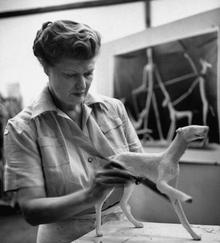
Mary Callery was an American artist known for her Modern and Abstract Expressionist sculpture. She was part of the New York School art movement of the 1940s, 1950s and 1960s.

Peter Laszlo Peri was an artist and sculptor.

Erwin Eisch was a German artist who worked with glass. He was also a painter, draughtsman, and printmaker. Eisch's work in glass, along with that of his friend and colleague Harvey Littleton, embodies the ideas of the international studio glass movement. Eisch is considered a founder of the studio glass movement in Europe.
Modular art is art created by joining together standardized units (modules) to form larger, more complex compositions. In some works the units can be subsequently moved, removed and added to – that is, modulated – to create a new work of art, different from the original or ensuing configurations.

Heather T. Hart is an American visual artist who works in a variety of media including interactive and participatory Installation art, drawing, collage, and painting. She is a co-founder of the Black Lunch Table Project, which includes a Wikipedia initiative focused on addressing diversity representation in the arts on Wikipedia.

Stella Kramrisch was an American pioneering art historian and curator who was the leading specialist on Indian art for most of the 20th century. Her scholarship remains a benchmark to this day. She researched and taught Indian art history for more than six decades on three continents. After writing her dissertation on the essence of early-buddhist sculpture in India, she was invited to teach at Kala Bhavana in Shantiniketan (1922–24) and went on to teach at Calcutta University from 1924 to 1950. In Europe, Kramrisch worked at the Courtauld Institute, London (1937–1940). From 1950, she was professor at the University of Pennsylvania in the Department of South Asia Regional Studies, where she had been recruited by W. Norman Brown, in addition to being a prominent curator at the Philadelphia Museum of Art.

Ree Morton was an American visual artist who was closely associated with the postminimalist and feminist art movements of the 1970s.
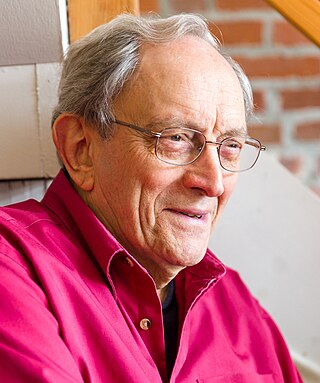
John T. Hill is an American artist. His work focuses mainly on design and photography.
Sidney Goodman was an American figurative painter and draftsman from Philadelphia, PA who explored the human form. Goodman received public notice in the early 1960s for his oil paintings, leading to his inclusion in the 1973 Whitney Biennial. In 1996, the Philadelphia Museum of Art presented a retrospective show of Goodman's paintings and drawings.
Ilse Getz was a German-born American painter and collagist active in New York and Newtown, Connecticut, from the 1950s through the 1980s. She specialized on three-dimensional works, made mostly with found objects. She exhibited at several galleries in New York City including the Bertha Schaefer Gallery and Rosenberg Gallery, as well as in Europe, namely in Switzerland, Germany, France and United Kingdom.
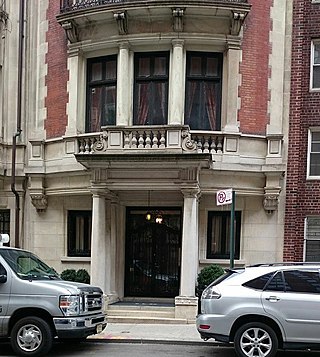
Galerie Chalette was a private contemporary art gallery in Manhattan, New York, USA. It was founded by the married art dealers and collectors Madeleine Chalette Lejwa (1915–1996) and Arthur Lejwa (1895–1972) in February 1954. The Lejwas were refugees from the Nazi invasions of Poland and France. Initially, their gallery specialized in contemporary French and Polish prints and painting. Later they changed its focus to contemporary 20th century American and European Sculpture, and especially the work of Jean Arp.
Stephanie Scuris (1931-2023) was a Greek-American artist and arts educator known for her large-scale Constructivist sculptures. She taught at the Rinehart School of Sculpture at the Maryland Institute College of Art in Baltimore, Maryland.
















